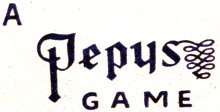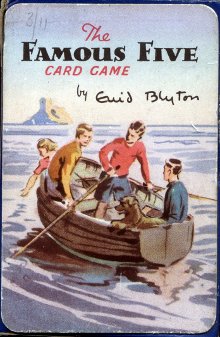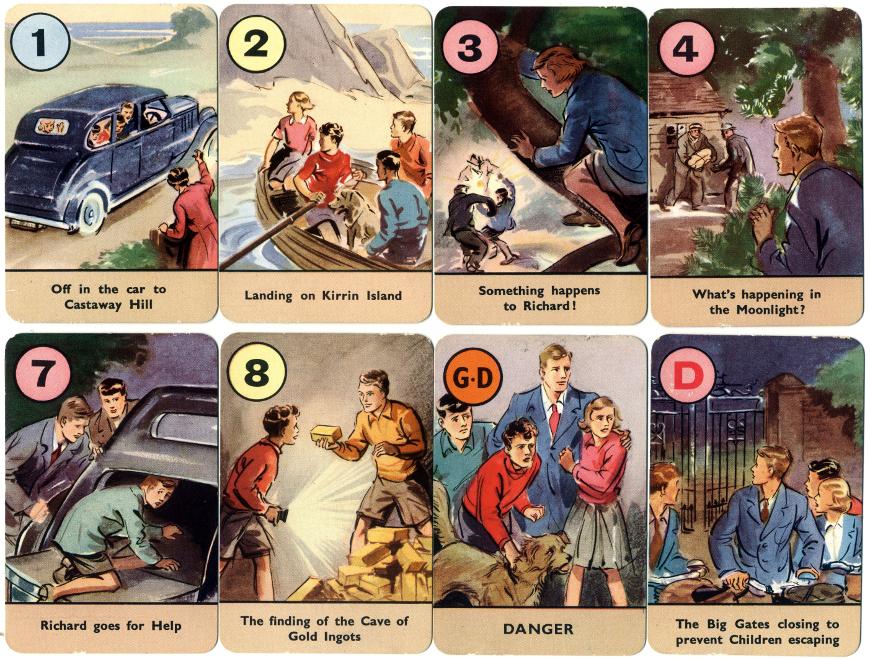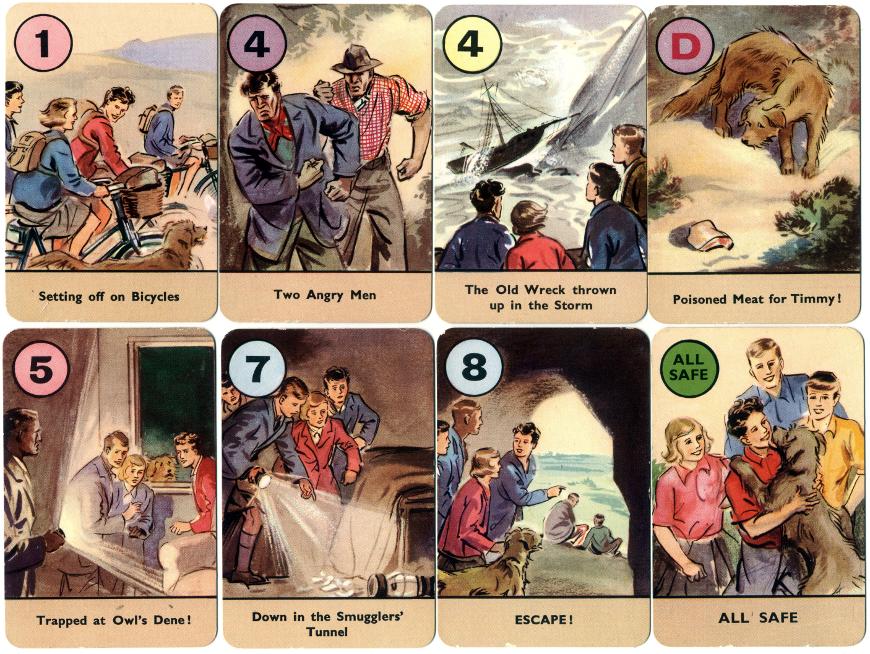Famous Five
The Famous Five Card Game by Enid Blyton.

The Famous Five Card Game, c.1951

The Famous Five Card Game by Enid Blyton (1897-1968) was illustrated by Eileen A. Soper and published by Pepys Games (Castell Brothers Limited), 14-17 St Cross Street, Hatton Garden, London E.C.1. in 1951. The card game is based on the Famous Five series of adventure books written by Enid Blyton for boys and girls, and depicts stories from four of the favourite books in the series. Blyton's total literary output was of an estimated 800 books over roughly 40 years. Some critics feel that Blyton's stereotyped depictions of gender, race and social class, coupled with a restricted use of language militates against the development of wider literary qualities in her readership.
Left: the title card from the box, showing the original retail price of three shillings and eleven pence.
The game has 44 cards consisting of four sets of 8 “Adventure” cards, four “Danger” cards, two “General Danger” cards and six “All Safe” cards. The object of the game is to be the first player to complete any set of “Adventure” cards by playing the No. 8 card.
The set is complete with an instruction booklet and a letter from Enid Blyton which introduces the new game. See also: Noddy Happy Families Wikipedia article about Enid Blyton


Above: cards from The Famous Five Card Game by Enid Blyton, published by Pepys Games. The game is based on four of the books about the adventures of the "Five" and the pictures on the cards are all of exciting incidents from the books.There are four complete sets of pictures and each set, when laid out in the correct order (which is the object of the game) tells the story, in pictures, of the book from which it is taken.
Pepys produced games from c.1938 until 1978. The more popular games continue to be published by Gibson Games.

By Simon Wintle
Member since February 01, 1996
I am the founder of The World of Playing Cards (est. 1996), a website dedicated to the history, artistry and cultural significance of playing cards and tarot. Over the years I have researched various areas of the subject, acquired and traded collections and contributed as a committee member of the IPCS and graphics editor of The Playing-Card journal. Having lived in Chile, England, Wales, and now Spain, these experiences have shaped my work and passion for playing cards. Amongst my achievements is producing a limited-edition replica of a 17th-century English pack using woodblocks and stencils—a labour of love. Today, the World of Playing Cards is a global collaborative project, with my son Adam serving as the technical driving force behind its development. His innovative efforts have helped shape the site into the thriving hub it is today. You are warmly invited to become a contributor and share your enthusiasm.
Related Articles

Scientific Whist
“Scientific Whist” : standard cards with instructions for play on the faces by Chas Goodall & Son, 1...

Agent Provocateur
Branded lingerie collection in a pack of pin-up playing cards.

Nimbus playing cards
Mike Steer’s weather-themed pack with suits in four colours and backs for cardistry.

Agatha Christie and Playing Cards revisited
Agatha Christie uses card-play as a primary focus of a story, and as a way of creating plots and mot...

The Decadent Deck
Studies in the eroticism of the female body by Inge Clayton.

Historic Shakespeare
“Historic Shakespeare” playing cards featuring Shakespearean characters by Chas Goodall & Son.

Copechat Paramount Sorting System
Preserving the past: a specimen deck showcasing edge-notched cards and their ingenious sorting syste...

Heartsette by Herbert Fitch & Co, 1893
A glimpse into a busy print and design office in late Victorian London.

Rap Rummy
Rap Rummy made by Parker Brothers in 1926, only 4 years after the discovery of King Tutankhamen’s to...

Batman® playing cards
Batman playing cards published by InterCol of London 1989.

Can You Believe Your Eyes?
“Can You Believe Your Eyes?” playing cards featuring visual illusions & other oddities.

Pastime Playing Cards for the Blind
The “Pastime” Playing Cards for the Blind manufactured by Goodall & Son Limd., c.1910.

The European Interchanges Quartets
A card game based around motorway intersections from European countries.

Songs with Flute accompaniment
Eighteenth century English engraved cards with music for voice and flute.

Love Tests
Vintage novelty “Love Test” cards of a slightly saucy nature but all in good fun!

Briefmarken-Quartett
Quartet game featuring postage stamps from the Zones of Occupation in post-WWII Germany.
Most Popular
Our top articles from the past 28 days

